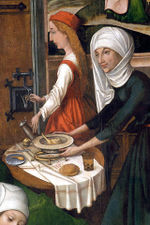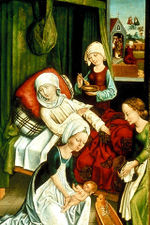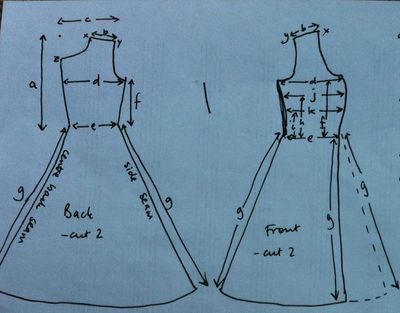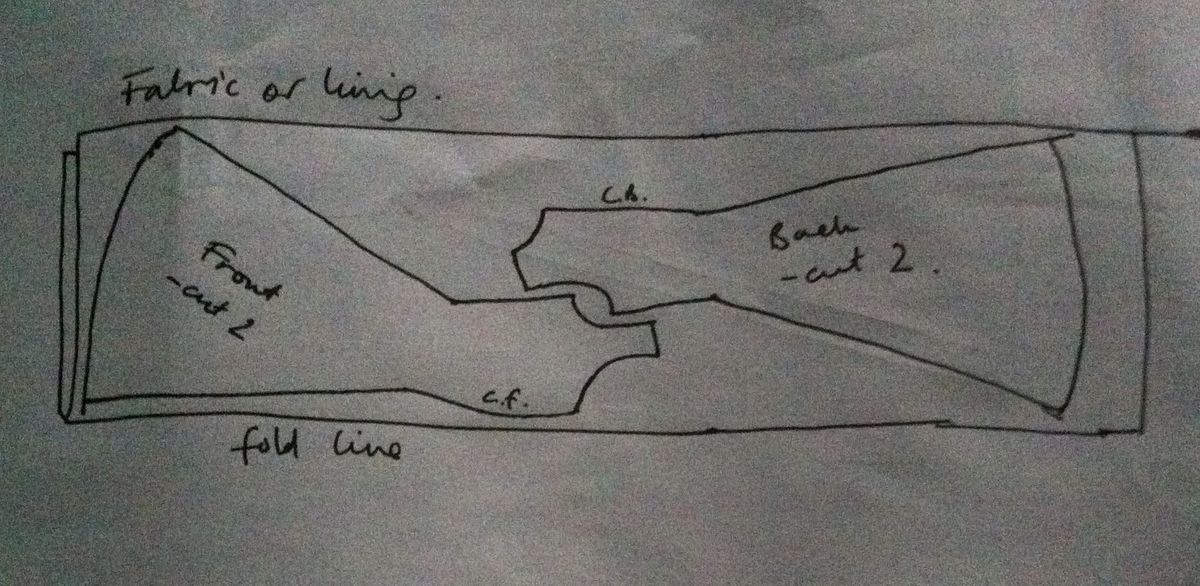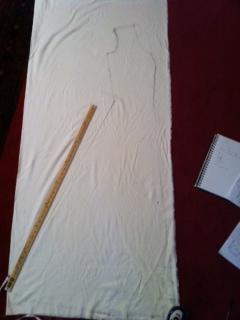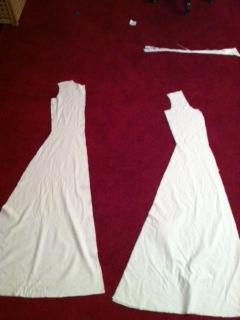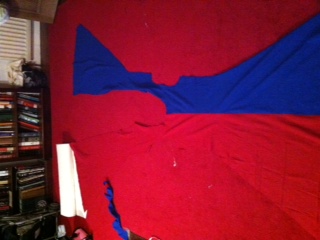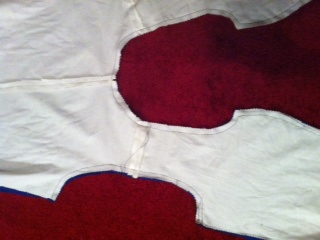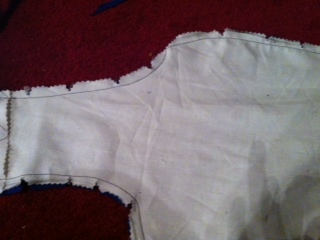How to - Make a kirtle
| Line 65: | Line 65: | ||
[[File:Kirtle7.jpg|400px|thumb|left|Front and back pieces cut out]] | [[File:Kirtle7.jpg|400px|thumb|left|Front and back pieces cut out]] | ||
Next you can use your lining pieces as a pattern for cutting out your outer fabric - cut them on the fold exactly as above. | Next you can use your lining pieces as a pattern for cutting out your outer fabric - cut them on the fold exactly as above. | ||
====Sewing it up==== | |||
If you have a preferred way of assembling garments then do it whichever way suits you! Here follows a step by step walkthrough for one way of many to do it. | |||
<b>Very important! The difference between a good outcome and a great one is pressing your seams as you go along. | |||
Set your iron up now beside your sewing table. Every time you sew a seam, press it open. You can sew a few then press them in batches to save time if you like, but don't sew across a seam before you've pressed it. Promise me! </b> | |||
* Sew the two back pieces of the lining together down the centre back seam. Press the seam open. Sew the fronts to the backs at the shoulder seams. Press the seams open. Repeat for the outer. | |||
[[File:Kirtle8.jpg|400px|thumb|left|The red half doesn't show up very well on the red carpet. Blue looks good though!]] | |||
* Next, lay your lining on top of your outer, right side to right side, matching seams and shapes. Make a mark or notch on both sides of the centre front about six inches below your waist. | |||
* Pin the two layers together around both armholes, and starting at the mark or notch you just made, pin them together up the centre front on one side, all the way round the neck and down the other side of the centre front until you reach the mark or notch again. | |||
* Stitch along your pin line around both armholes, and from the notch or mark to the matching one on the other side as you just pinned them. | |||
[[File:Kirtle9.jpg|400px|thumb|left|You can see the stitching line around one armhole and around the neckline in this picture]] | |||
*Now clip your curves. This means cutting little v shaped notches out of your seam allowance, almost to your stitching line, which allows the fabric to curve neatly when you turn it the right way out. | |||
[[File:Kirtle10.jpg|400px|thumb|left|Once you've clipped your curves it should look a bit like this]] | |||
* Now, pull the fronts through the shoulder straps to turn them the right way out. Suddenly this should start looking a lot like a finished project! | |||
====Sewing them together==== | ====Sewing them together==== | ||
Revision as of 21:56, 11 July 2013
How to make a Kirtle
What's a kirtle, I hear you ask? Well, it's a term used to describe a close fitting dress or underdress, worn through a lot of the middle ages. The one we're going to make today is roughly based on the ones they were wearing in the 15th century, and it's a lovely comfortable and practical garment that's cool in summer and works as a great underlayer in winter. This one is sleeveless but you could add sleeves, or make a separate pair and lace or pin them on for a different look.
If you're part of the Marcher Authenticity Brigade (of which I'm a fully paid up obsessional member) you'll be pleased to see these historical images of women wearing sleeveless kirtles just like the ones we're going to make. In late 15th century art you see women painted in domestic situations in just this kind of sleeveless kirtle, particularly in pictures about births. For everyone else, they do look cool, don't they?
You will need
- 3m of cotton, linen or lightweight wool, 60 inches wide (if you're making a particoloured dress like mine get 1.5m of each) (I used linen look cotton at £5 per metre - you could use ikea coloured cotton at £3 per metre if you wanted something cheaper - £15)
- 3m of cotton lining (Bomull from ikea is great - £1.75 per metre for unbleached calico) (£5.25)
- Thread in a matching or darker colour. (TIP: if you think you might dye the garment later, get cotton or silk thread. Normal sewing thread won't dye and you'll end up with visible stitching. Coats cotton thread is very good. Guterman quilting cotton thread is too coarse.) (£1)
- A tape measure
- A pen, soft pencil or chalk
- A packet of eyelets (£4)
- 2-3 metres of ribbon, cotton tape or cord (£1)
- An iron
Total cost - £26.25
The Basic Process
What we're going to do is draw a simple pattern consisting of two back and two fronts based on your body measurements. We'll then assemble the lining and the outer fabric step by step, with no visible machine stitching or need for hand finishing except for the bottom hem which you can choose to finish by machine or by hand depending on your preference. There are quite a few steps to the process but none of them is hard, and by taking it a bite at a time even a beginner can make a success of the project.
Making your pattern
These are the two pattern pieces that you're going to map out. As written you'll get a pattern for a close-fitting, supportive dress with little or no ease - if you're anxious about the fit or want a looser kirtle then add a couple of inches to the seam allowances at the sides, and pin it to check the fit and adjust before you start sewing.
Key to measurements
- a)nape of neck to waist + 1/2 an inch. Point z is 2 inches below this line.
- b)base of neck to shoulder - point x should be about 1 inch higher than point y so the shoulder line slopes nicely.
- c)1/2 inch + 1/2 of the distance between your shoulders measured behind your head
- d)1 inch + 1/4 of your underbust measurement
- e) 1 inch + 1/4 of your waist measurement
- f) waist to armpit measurement (get the tape right into your armpit!)
- g) waist to ankle + 2 inches
- h) nipple level to waist, measured straight down your side (don't measure down the curve of your breast)
- i) underbust level to waist, measured straight down your side
- j) 1 inch + 1/2 x (bust measurement - 1/2 your underbust measurement)
- k) 1 inch + 1/4 of your underbust measurement
The straight line and the dotted line down the front piece show two alternative cutting lines for the front skirt. If you're not very curvy (like me) it's can look nice to have a relatively straight front to this. Alternatively if you want more volume in the skirts or have more of a difference between your waist and hip measurements you can flare it along this seam line too. If you want lots more volume in your skirts you could add triangular gores of fabric down the lines marked g.
Cutting out your pieces
Fold your lining fabric in half across the way, selvedge to selvedge. You can either scale your pattern up on pattern paper or newspaper then lay it on, or draw it directly on to your fabric - either works. The picture below shows roughly how you can arrange them - depending on your size you might get a more efficient layout than I have. If you're experienced and happy to play around with it you can waste less fabric if you cut gores to give the skirts more width - you can even add them to this pattern out of your leftover scraps if you want.
You can see from the faint lines in the picture below how the back looks drawn directly on to the fabric.
And now cut them out - you should have two front, and two back pieces of lining as below.
Next you can use your lining pieces as a pattern for cutting out your outer fabric - cut them on the fold exactly as above.
Sewing it up
If you have a preferred way of assembling garments then do it whichever way suits you! Here follows a step by step walkthrough for one way of many to do it.
Very important! The difference between a good outcome and a great one is pressing your seams as you go along.
Set your iron up now beside your sewing table. Every time you sew a seam, press it open. You can sew a few then press them in batches to save time if you like, but don't sew across a seam before you've pressed it. Promise me!
- Sew the two back pieces of the lining together down the centre back seam. Press the seam open. Sew the fronts to the backs at the shoulder seams. Press the seams open. Repeat for the outer.
- Next, lay your lining on top of your outer, right side to right side, matching seams and shapes. Make a mark or notch on both sides of the centre front about six inches below your waist.
- Pin the two layers together around both armholes, and starting at the mark or notch you just made, pin them together up the centre front on one side, all the way round the neck and down the other side of the centre front until you reach the mark or notch again.
- Stitch along your pin line around both armholes, and from the notch or mark to the matching one on the other side as you just pinned them.
- Now clip your curves. This means cutting little v shaped notches out of your seam allowance, almost to your stitching line, which allows the fabric to curve neatly when you turn it the right way out.
- Now, pull the fronts through the shoulder straps to turn them the right way out. Suddenly this should start looking a lot like a finished project!
Sewing them together
Next: Sewing them together!
Hungry for more?
Why not use the How to make a t-tunic tutorial to make a shift to go under it - if you get an extra 2m of ikea bomull cotton it makes a great lightweight underlayer and you're still under £30!
